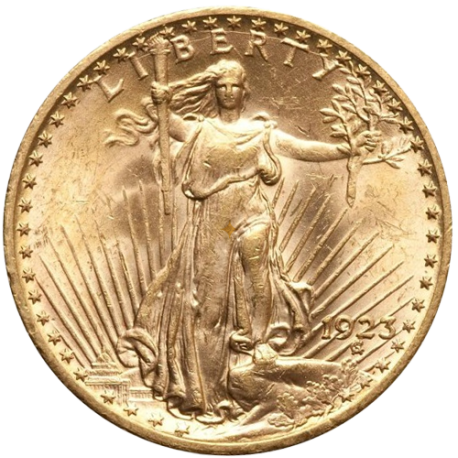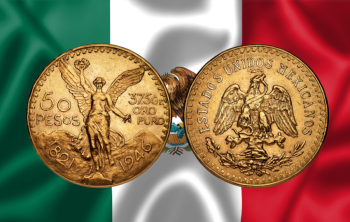How to BuySee the full summary
Buy at the counter
20 dollars St Gaudens gold
-
30.09 g
-
33.436 g
-
 USA
USA
-
900.0‰
-
1907
-
Gold
-
American coins
Brief Summary of the $20 Saint-Gaudens Double Eagle
The Saint-Gaudens double eagle is a twenty-dollar gold coin that was created in 1907 and served as a means of exchange in the United States of America between 1907 and 1933. It is named after the sculptor Augustus Saint-Gaudens, who is its designer. Saint-Gaudens designed both the obverse and reverse sides of the coin. He also designed the new $10 coin, showing Liberty in a feathered bonnet. It is colloquially known today as the Ten Dollar Indian Head. Like the $20, it went through various stages of experimental strikes and patterns until the mint arrived at a version it felt it could use for mass production. Even this first version of the Ten Dollar coin was modified in 1908.
The Saint-Gaudens double eagle replaced the Liberty Head double eagle, which had been in circulation since 1850. The Saint-Gaudens double coin was also the last twenty-dollar coin ever (replaced by the 50$ coin in 1986), and many collectors today consider it the most beautiful of all US coins.
The coin's production started after President Theodore Roosevelt sought to beautify American coinage. Roosevelt proposed that Saint-Gaudens design the coin, and although he (Saint-Gaudens) had issues with the Mint and its chief engraver, Charles E. Barber, he agreed to do it.
Unfortunately, St. Gaudens was already fighting a losing battle with lung cancer in 1907. The first patterns were the last of his $20 coins that he saw. At first, the patterns were struck in deep medallic relief, and had the date in Roman Numerals. Less than 20 of these coins survive, and even these have differences among them. They are known as “Ultra High Relief,” and they required over ten blows from the dies to bring up all the details. The mint had to modify the design in order to produce even 11,000 coins with a modified high relief. These coins did not stack well, and still required five blows from the dies to bring up the modified relief. They still had the date, 1907, in Roman numerals. After St. Gaudens died, the mint was successful in protesting the difficulty in producing his design, and was authorized to drastically modify it to a flatter relief, better designed for mass production.
President Theodore Roosevelt objected to the name of God on coins, so when the new $10 and $20 coins designed by St. Gaudens came out, they lacked the motto, “In God We Trust.” Congress restored the motto in 1908, and late in 1908, this motto was restored to the $10 and $20 coins.
Design of the Coin
The obverse side of the coin contains the female figure of liberty (derived from the Roman goddess Libertas). Lady Liberty holds a torch in her right hand, symbolizing enlightenment, and an olive branch in her left hand, representing peace. She strides across a rocky outcrop with her left foot raised. Behind the image of Lady Liberty are the US Capitol and the sun’s rays. She is surrounded by 46 stars, one for every state in the Union as of 1907. In 1912, Arizona and New Mexico, up to then territories, joined the United States, so Congress enacted a law increasing the number of stars on the $20 coin to 48 from then on.
There is a flying eagle facing west on the coin's reverse side. Behind the eagle are the sun’s rays which complement the obverse design. Also, the production date is written directly below the earising eagle in Roman numerals.Also, the date of issue appears to the right—facing the coin—of Liberty’s raised leg. An anagram of ASG, for Augustus St. Gaudens, appears below the date. The first coins with high relief still had the date of 1907 in Roman Numerals. Later in 1907, and from then until the end of production in 1933, the date appears in Arabic numerals.
The coin's edge has the words “E PLURIBUS UNUM” because Saint-Gaudens couldn’t find space on the obverse side, and he felt that adding them to the reverse side would spoil the balance.
World War 1 and the End of the Coins
During World War 1, the minting of the Saint-Gaudens coins was halted because bullion prices were high. Banks and other coin holders refused to pay them out, so they disappeared from circulation. Coinage resumed in 1920, and the coins were struck again in large numbers, but most of it was held by banks and used for international trade.
In 1933, President Franklin Roosevelt prohibited citizens from holding monetary gold and asked that all Americans return their gold coins to the US Treasury, where millions were melted and turned into gold bars.
Aftermath
Today, the rare Saint-Gaudens Double Eagle gold coins that exist are hard to find, and the ones that have been found are costly. For example, in June 2021, a 1933-Saint Gaudens double eagle coin sold for about $18.9 million, making it the most money spent on a collectible coin.








